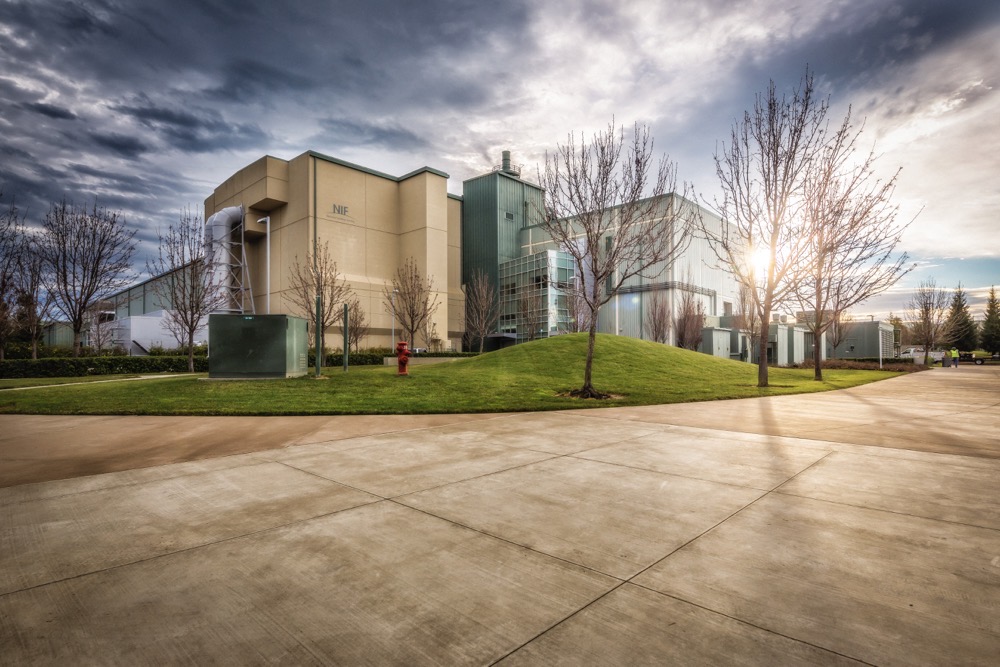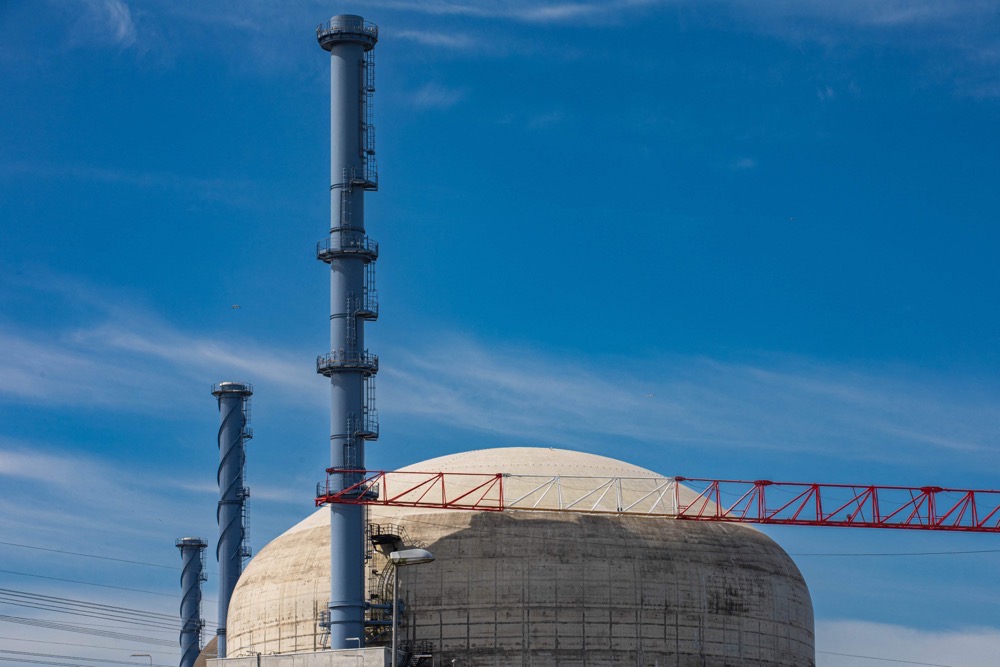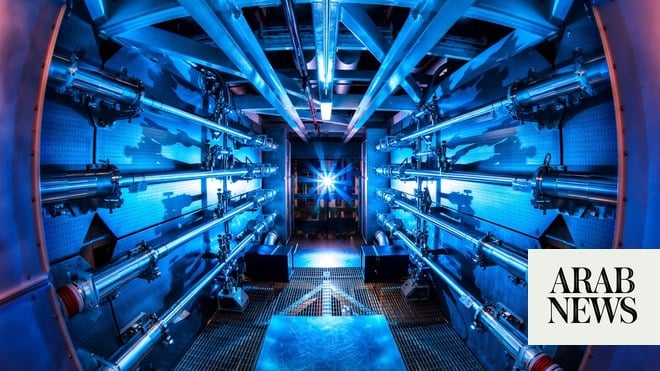[ad_1]
LONDON: It has taken eight many years, value billions of {dollars} and consumed the careers of generations of physicists.
However final week scientists at a US government-funded laboratory in California claimed to have cracked the long-elusive puzzle of nuclear fusion, within the course of producing sufficient power to boil a number of kettles.
That, in fact, was not the tip recreation for researchers on the $3.5 billion Nationwide Ignition Facility, which started working on the Lawrence Livermore Nationwide Laboratory in 2010.
Because it opened, the NIF’s crew has been edging towards the last word purpose of making a brand new, clear and in the end free supply of power — an ambition that has develop into ever extra vital, and more and more pressing, as the specter of world warming brought on by the burning of fossil fuels has grown ever higher.
The world already has nuclear power, in fact, however presently it’s created by a course of often known as fission, which entails splitting atoms. It was found in 1938 and developed initially because the expertise behind the creation of the primary atomic bomb in 1945.
Fusion, alternatively, is technically a lot more durable to attain than fission however in the end safer and simpler to work with. It operates by forcing two atoms collectively and within the strategy of doing in order that they launch power.
Fusion eliminates the potential hazard for an out-of-control chain response that exists with fission, there isn’t any radioactive waste to eliminate, and now we have an ample provide of the required uncooked materials: hydrogen.
Fusion can be a course of all of us witness every day: It’s what generates the Solar’s power. Replicating it in a laboratory, nevertheless, is way simpler mentioned than carried out.
Over the previous 80 years a fusion reactor has been a dream that proved so elusive that at occasions it has appeared no extra practical than the traditional perception amongst alchemists that base metals might be remodeled into gold.

So no doubt, this month’s “kettle second” in California is essentially the most vital milestone but, summed up by the straightforward phrase: “Extra power out than in.” For the primary time within the lengthy historical past of fusion analysis, the LLNL introduced, an experiment had produced extra power from fusion than was used to create it.
This was “a serious scientific breakthrough, many years within the making, that may pave the best way for developments in … the way forward for clear energy.”
In keeping with the LLNL, the experiment “surpassed the fusion threshold by delivering 2.05 megajoules of power to the goal, leading to 3.15 MJ of fusion power output, demonstrating for the primary time a most elementary science foundation for inertial fusion power,” or IFE.
Jennifer M. Granholm, the US secretary of power, hailed it as “a landmark achievement for the researchers and workers on the Nationwide Ignition Facility, who’ve devoted their careers to seeing fusion ignition develop into a actuality.”
However regardless of the hyperbole, fusion energy isn’t any “white knight” expertise, about to come back galloping to the planet’s rescue. For years it has been a standing joke amongst nuclear physicists that fusion era is at all times 20-to-30 years away — and, by most accounts, we’re nonetheless no less than twenty years away from that actuality.
For a begin, the NIF achievement is just not fairly what it might sound, in line with physicist and lecturer Tony Roulstone, founder and director of the nuclear engineering course on the College of Cambridge within the UK.
“Though very constructive information, this end result remains to be a great distance from the precise power acquire required for the manufacturing of electrical energy,” he instructed Arab Information.
Though the experiment produced — only for a fraction of a second — 3.15 MJ of fusion power output utilizing 2.05 MJ of laser power, “they needed to put 500 MJ of power into the lasers … so despite the fact that they bought 3.15 MJ out, it’s nonetheless far lower than the power they wanted for the lasers within the first place,” mentioned Roulstone.
“In different phrases, the power output was nonetheless solely 0.5 % of the enter. Due to this fact we are able to say that this end result from NIF is successful of the science — however nonetheless a great distance from offering helpful, ample, clear power,” he added.
As British physicist Andrew McKinnon, a member of the diagnostics crew on the LLNL, admitted throughout an interview on BBC Radio this week: “That is superb … however there are much more steps earlier than we get to an influence station.”
The NIF is an enormous, warehouse-like constructing the scale of three soccer pitches. Inside is a large “goal chamber” at which 192 laser beams are pointed. Their goal is a small gold container holding a peppercorn-sized capsule inside which is a small quantity of hydrogen.
The lasers warmth the capsule to 100 million levels Celsius. At this temperature the hydrogen is remodeled from a gasoline into plasma — the so-called fourth state of matter, after strong, liquid and gasoline — during which its atoms could be fused collectively, releasing power.
However, as McKinnon defined, the profitable experiment was merely an train in proof of idea and scaling it as much as power-station ranges would require a completely completely different strategy.

“It’s not designed to do this,” he mentioned. “It’s like a one-shot-every-two-weeks sort of machine. You would want a a lot larger repetition price to be attaining this kind of end result, however with 100 occasions the power and at 10 occasions each second.”
The US Division of Vitality itself concedes that “many superior science and expertise developments are nonetheless wanted to attain easy, reasonably priced IFE to energy houses and companies.” To that finish, the company is launching “a broad-based, coordinated IFE program within the US” and hopes “the momentum” created by the NIF breakthrough will appeal to “private-sector funding … to drive speedy progress towards fusion commercialization.”
The scaling as much as business energy era will virtually definitely be achieved by a number of of the various fusion startups which have been established prior to now few years, in line with physicist Pravesh Patel, a former scientist on the LLNL who this 12 months left to affix US-German start-up Centered Vitality as its scientific director.
“Till now, fusion has at all times been a authorities venture in all places around the globe,” he instructed Arab Information. “The massive factor that’s modified prior to now couple of years is personal funding within the expertise, which now significantly exceeds that of governments, and that’s now the massive recreation changer.”
Fusion, Patel added, “is, on the finish of the day, a business product which, if it really works, might produce power to interchange fossil fuels and be aggressive with different power sources. Vitality is the most important market on the earth, clearly, so it might probably make an enormous sum of money.”
Centered Vitality is working at its facility in Austin, Texas, to create an improved model of the NIF laser-based expertise designed to be able to producing 100 occasions as a lot internet power. However this, too, is a great distance off.
“We’re demonstrating commercially viable expertise through the 2030s and delivering electrical energy onto the grid as quickly because the early 2040s,” mentioned Patel.
That, in fact, means it might don’t have any affect on the newest UN local weather predictions. Even when all present emissions pledges are adhered to, the world remains to be on the right track for two.5 levels Celsius of warming by the tip of the century. At present charges, by 2030 emissions of greenhouse gases may have elevated by 10.6 % in contrast with 2010 ranges.
For this reason, Patel mentioned, “within the subsequent 20 years now we have to do the whole lot we are able to to make use of extra non-fossil fuels, together with nuclear fission and different current applied sciences, and ramp up the usage of renewables akin to photo voltaic and wind.”
If the planet can maintain the road within the meantime, “we see fusion because the long-term base load” — the essential demand on any electrical energy grid — “hopefully by the 2040s, inevitably by the 2050s and 2060s, after which for hundreds of years to come back.”
Each the UAE and Saudi Arabia are investing closely in current nuclear fission expertise. Within the UAE, the Barakah Nuclear Energy Plant is already operational and can ultimately provide 25 % of the nation’s energy.
Such investments are clever, mentioned Patel, as current nuclear expertise is an important part within the present power combine and can be wanted to bridge the hole within the coming many years.
Moreover, mentioned Jonathan Cobb, senior communications supervisor on the World Nuclear Affiliation, whereas “fusion could ultimately contribute to raised methods of assembly world power wants, it isn’t a direct alternative for fission simply because each are nuclear, any greater than photo voltaic is a direct alternative for wind simply because each are renewables.”
He added: “Hopefully, fusion will discover its place within the clean-energy combine, and the longer term will inform how giant its function can be.”

Following the profitable experiment on the NIF, ought to nations akin to Saudi Arabia now be investing in fusion in addition to fission?
“Nuclear fusion might probably play a big function in assembly world power wants someday within the second half of the twenty first century,” mentioned Cobb. “However its success is much from sure and we must be transferring to a world clear power combine a lot sooner.”
Nuclear fission, alternatively, “is a confirmed expertise supplying 10 % of the world’s electrical energy immediately, with many superior applied sciences prepared for business deployment,” he mentioned.
“Fusion could also be one space of analysis during which Saudi needs to take a position. Nevertheless it must also be accelerating its deployment of nuclear fission, together with different clean-energy applied sciences, in any other case we can be going through severe world results of local weather change earlier than the primary fusion energy plant might ever be deployed.”
[ad_2]
Source link


